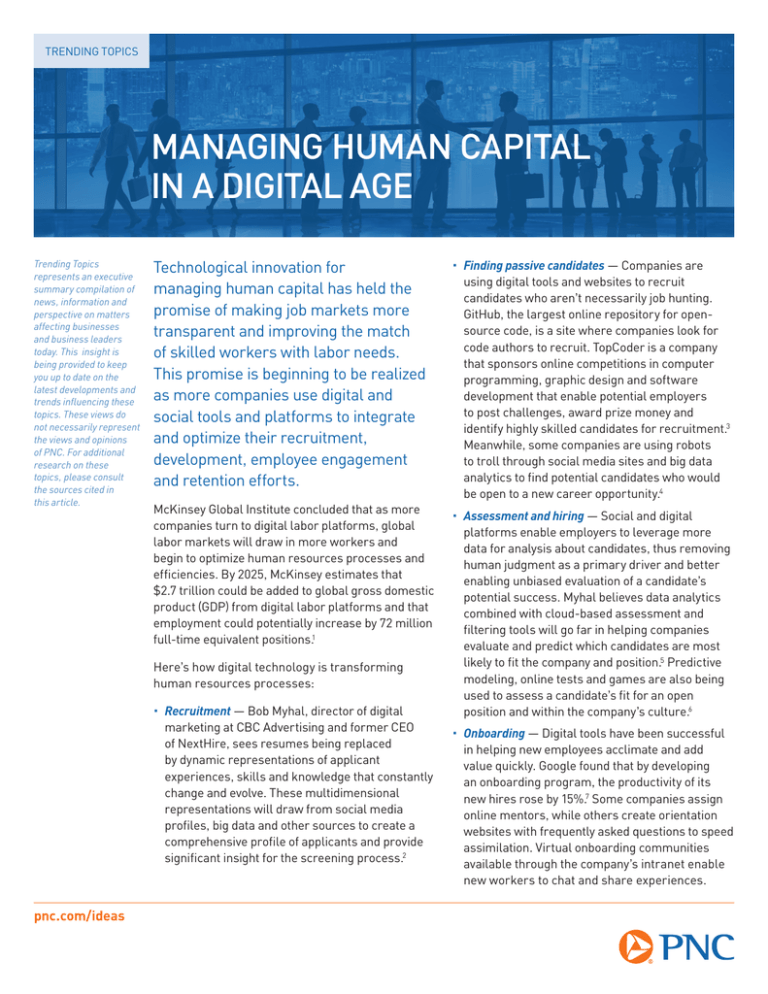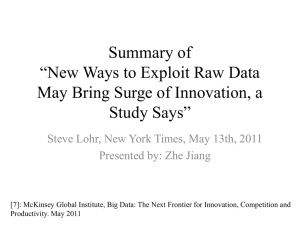
TRENDING TOPICS
MANAGING HUMAN CAPITAL
IN A DIGITAL AGE
Trending Topics
represents an executive
summary compilation of
news, information and
perspective on matters
affecting businesses
and business leaders
today. This insight is
being provided to keep
you up to date on the
latest developments and
trends influencing these
topics. These views do
not necessarily represent
the views and opinions
of PNC. For additional
research on these
topics, please consult
the sources cited in
this article.
Technological innovation for
managing human capital has held the
promise of making job markets more
transparent and improving the match
of skilled workers with labor needs.
This promise is beginning to be realized
as more companies use digital and
social tools and platforms to integrate
and optimize their recruitment,
development, employee engagement
and retention efforts.
• Finding passive candidates — Companies are
using digital tools and websites to recruit
candidates who aren’t necessarily job hunting.
GitHub, the largest online repository for opensource code, is a site where companies look for
code authors to recruit. TopCoder is a company
that sponsors online competitions in computer
programming, graphic design and software
development that enable potential employers
to post challenges, award prize money and
identify highly skilled candidates for recruitment.3
Meanwhile, some companies are using robots
to troll through social media sites and big data
analytics to find potential candidates who would
be open to a new career opportunity.4
McKinsey Global Institute concluded that as more
companies turn to digital labor platforms, global
labor markets will draw in more workers and
begin to optimize human resources processes and
efficiencies. By 2025, McKinsey estimates that
$2.7 trillion could be added to global gross domestic
product (GDP) from digital labor platforms and that
employment could potentially increase by 72 million
full-time equivalent positions.1
• Assessment and hiring — Social and digital
platforms enable employers to leverage more
data for analysis about candidates, thus removing
human judgment as a primary driver and better
enabling unbiased evaluation of a candidate’s
potential success. Myhal believes data analytics
combined with cloud-based assessment and
filtering tools will go far in helping companies
evaluate and predict which candidates are most
likely to fit the company and position.5 Predictive
modeling, online tests and games are also being
used to assess a candidate’s fit for an open
position and within the company’s culture.6
Here’s how digital technology is transforming
human resources processes:
•Recruitment — Bob Myhal, director of digital
marketing at CBC Advertising and former CEO
of NextHire, sees resumes being replaced
by dynamic representations of applicant
experiences, skills and knowledge that constantly
change and evolve. These multidimensional
representations will draw from social media
profiles, big data and other sources to create a
comprehensive profile of applicants and provide
significant insight for the screening process.2
pnc.com/ideas
• Onboarding — Digital tools have been successful
in helping new employees acclimate and add
value quickly. Google found that by developing
an onboarding program, the productivity of its
new hires rose by 15%.7 Some companies assign
online mentors, while others create orientation
websites with frequently asked questions to speed
assimilation. Virtual onboarding communities
available through the company’s intranet enable
new workers to chat and share experiences.
Technological innovation for managing human
capital has held the promise of making job
markets more transparent and improving the
match of skilled workers with labor needs.
• Employee engagement and retention —
Employee engagement has gone digital too,
moving beyond the employee satisfaction
survey. Digital screening tools can help predict
not only a successful fit for new hires, but
also identify which employees are at risk of
leaving the company. This can prompt actions
such as mentoring, a new job assignment,
or advancement to improve satisfaction
and engagement.8
For many employees, connecting personal
values to the work improves engagement
and increases job satisfaction. Social media
use policies vary by company, but many
organizations are viewing social media as a
way to give employees a voice on issues that
matter most to them. Social media can improve
employee engagement and retention, as well
as humanize the company’s public image.9
The payoff from integrating digital human
capital tools into a cohesive labor platform
can be significant. McKinsey estimates that
such platforms could increase output by nearly
9%, reduce employee-related costs by 7%, and
improve profit margins by an average of 275
basis points.10 Digital labor platforms can help
companies optimize human resource functions,
increase productivity and strengthen corporate
culture by improving employee job satisfaction
and engagement.
To discuss these topics in more detail,
please contact your PNC Relationship
Manager.
1 “Connecting talent with opportunity in the digital age,” a report by James Manyika, Susan Lund, Kelsey Robinson, John Valentino and Richard Dobbs, McKinsey Global Institute, June 2015.
Available at: http://www.mckinsey.com/global-themes/employment-and-growth/connecting-talent-with-opportunity-in-the-digital-age
2 “Hiring in the Digital Age: What’s Next for Recruiting?” by Nicole Fallon Taylor, Business News Daily, Jan. 11, 2016.
Available at: http://www.businessnewsdaily.com/6975-future-of-recruiting.html
3 “Managing talent in a digital age,” McKinsey Quarterly, March 2016. Available at: http://www.mckinsey.com/industries/high-tech/our-insights/managing-talent-in-a-digital-age
4 “Hiring in the Digital Age: What’s Next for Recruiting?” by Nicole Fallon Taylor, Business News Daily, Jan. 11, 2016.
Available at: http://www.businessnewsdaily.com/6975-future-of-recruiting.html
5 “Hiring in the Digital Age: What’s Next for Recruiting?” by Nicole Fallon Taylor, Business News Daily, Jan. 11, 2016.
Available at: http://www.businessnewsdaily.com/6975-future-of-recruiting.html
6 “Managing talent in a digital age,” McKinsey Quarterly, March 2016. Available at: http://www.mckinsey.com/industries/high-tech/our-insights/managing-talent-in-a-digital-age
7 “Managing talent in a digital age,” McKinsey Quarterly, March 2016. Available at: http://www.mckinsey.com/industries/high-tech/our-insights/managing-talent-in-a-digital-age.
8 “Managing talent in a digital age,” McKinsey Quarterly, March 2016. Available at: http://www.mckinsey.com/industries/high-tech/our-insights/managing-talent-in-a-digital-age
9 “Employee Engagement in the Digital Age,” by Christopher P. Skroupa, Forbes, April 19, 2016.
Available at: http://www.forbes.com/sites/christopherskroupa/2016/04/19/employee-engagement-in-the-digital-age/#1085838d4409
10“Managing talent in a digital age,” McKinsey Quarterly, March 2016. Available at: http://www.mckinsey.com/industries/high-tech/our-insights/managing-talent-in-a-digital-age
PNC is a registered mark of The PNC Financial Services Group, Inc. (“PNC”).
This article was prepared for general information purposes only and is not intended as legal, tax or accounting advice or as recommendations to engage in any specific transaction, including
with respect to any securities of PNC, and do not purport to be comprehensive. Under no circumstances should any information contained in this article be used or considered as an offer or
commitment, or a solicitation of an offer or commitment, to participate in any particular transaction or strategy. Any reliance upon any such information is solely and exclusively at your own
risk. Please consult your own counsel, accountant or other advisor regarding your specific situation. Neither PNC Bank nor any other subsidiary of The PNC Financial Services Group, Inc. will
be responsible for any consequences of reliance upon any opinion or statement contained here, or any omission. The opinions expressed in this article are not necessarily the opinions of PNC Bank
or any of its affiliates, directors, officers or employees.
©2016 The PNC Financial Services Group, Inc. All rights reserved. pnc.com/ideas
CIB ENT PDF 0616-0136-324501



